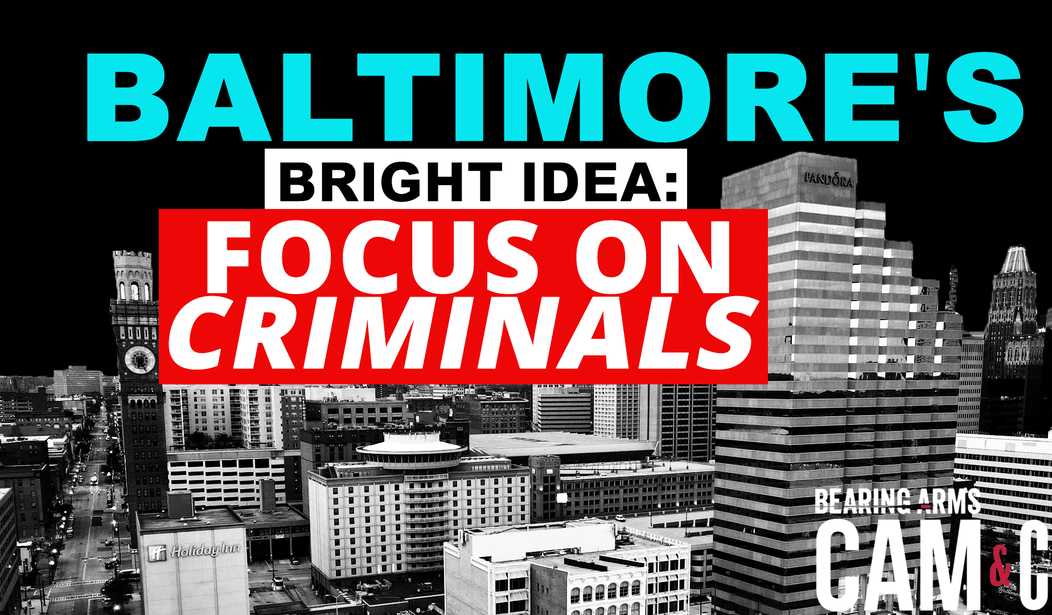As far as strategies go, it’s much better than passing more gun control laws aimed at legal gun owners, but as we explain on today’s Bearing Arms’ Cam & Co, the city’s new “focused deterrence” effort targeting the most violent offenders seems to be long on carrots and short on sticks.
First, let’s focus on the good news. For once, Democrats in Baltimore are actually basing their crime fighting strategy on actual criminals rather than demanding more laws restricting our right to keep and bear arms. This is a notable change from recent years, though it’s also worth noting that Maryland already put a lot of draconian gun laws on the books back in 2013 with the passage of the Maryland Firearms Safety Act, which was signed into law by then-Governor Martin O’Malley, a former mayor of Baltimore.
Still, any crime fighting effort that’s aimed at criminals is sure to be more successful than one aimed at restricting the rights of legal gun owners, so I applaud the Baltimore officials who want to focus their efforts on deterring the most violent and prolific offenders from further acts of violence.
Having said that, focused deterrence works best when there are both opportunities to criminals to change, and consequences if they don’t. Baltimore’s new effort seems like it’s going to have far more of the former, and not much of the latter.
The plan has three initiatives: offering necessary support services to those who are vulnerable to committing crimes, revamping the intelligence hubs so that law enforcement can accurately and better gather information about individuals and hiring a team of directors and coordinators to see the program succeed.
Anthony Braga, a nationally known expert on gun issues from Northeastern University has been nominated to oversee the program.
The plan is expected to cost an estimated $1.8 million dollars over the span of three years, which the department has already received most of through grants and donations. The grant money will go towards hiring social workers that are skilled in working with these people.
In order for the plan to work, the city needs to devote time and resources to see it through to fruition. City officials know this to be true as it’s not the first time they’ve tried to implement it.
The city attempted focused deterrence measures twice in the past, once in the late 1990s and again in 2014.
According to the Baltimore Sun, neither saw much success.
There’s no mention of working with the U.S. Attorney’s office and federal law enforcement to refer cases to the federal court system when criminals decide not to take advantage of the opportunity to change their ways. Moving those prolific and unrepentant offenders into federal court is a key strategy in order to see the best results of focused deterrence, but the city seems almost entirely focused on more social programs rather than a balanced approach.
By the way, David Kennedy, a professor of criminal justice at John Jay College in New York actually writes about Baltimore’s attempt at focused deterrence in the 1990s in his book Don’t Shoot: One Man, A Street Fellowship, and the End of Violence in Inner-City America, and he places the blame for the failure on agencies at odds with each other in rolling out the program, as well as a lack of interest by newly elected mayor Martin O’Malley, who went with an “arrest everyone” approach instead. Arrests soared in Baltimore, but so did violent crime.
It wasn’t until after O’Malley signed the Firearms Safety Act that things became truly horrific in Baltimore. The city’s long been plagued with a high crime rate, but since 2015 the city has seen more than 300 homicides every year, and in 2019 set a record for the highest per capita homicide rate in the city’s history.
Clearly Maryland’s gun control laws have failed to keep Baltimore residents safe. I just wish that Baltimore’s new strategy paid more attention to criminal prosecution in addition to providing opportunities for redemption.








Join the conversation as a VIP Member